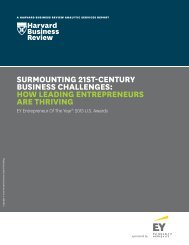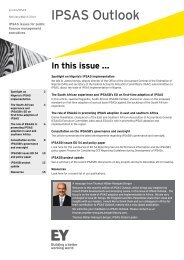You also want an ePaper? Increase the reach of your titles
YUMPU automatically turns print PDFs into web optimized ePapers that Google loves.
Africa 2030: Points of viewIt’s a sunny day in Accra, Africa’s newest regional business hub in 2030Jean-Louis WarnholzJean-Louis Warnholz Founding Principal and Managing Director’, BlackIvy LLC, an investmentcompany that builds and grows enterprises in logistics, real estate and consumer goods and servicesin Sub-Saharan Africa (with a particular focus on Ghana, Kenya and Tanzania).It’s a sunny afternoon in August 2030 as our plane approachesAccra International Airport. The dry season has lived up toexpectations this year and the resorts that dot Ghana’s lush Atlanticbeaches are booked to capacity. It has been a restful flight fromNew York. The increasing competition on the busy JFK to Accraroute has markedly increased the comfort of flying. Gone are thetired and overcrowded planes. As I step into Accra’s light-filledarrival hall and glance at the frequent connections to Nairobi, Dares Salaam, Lagos, Abidjan, Dakar, Addis and Maputo it strikes mejust how far this country and this continent has come in the fifteenyears since our company opened our first Africa office in Ghana.Ghana’s economy has tripled in size. Deep, structural shiftstransformed the country from an exporter of mostly rawcommodities into an industrial hub that last year registered morepatents than the United Kingdom and moved to 10th place inBloomberg’s ranking of the most innovative economies. Ghanahas upgraded its power, road, rail, port and airport infrastructurethroughout and is in good shape for hosting the FIFA World Cup in2034, jointly with neighbouring Nigeria.Looking back, two major developments played out in Ghana andunderline the positive economic trends we witnessed across West,East and Southern Africa.The first was the concerted effort by the Economic Community ofWest African States (ECOWAS), the East African Community (EAC)and the Southern African Development Community (SADC) to leadthe way in further integrating their markets. Other regional blocssoon followed. The free movement of people and goods presenteda sea change for local companies. It opened opportunities forexpansion across borders that previously were constrained by theregulatory and physical challenges of trading regionally in Africa.Today, the US $1.5 trillion ECOWAS, the US $1 trillion SADC andthe US $350 billion EAC market hold more bargaining power ininternational trade negotiations and have secured attractive tradepreferences with South America and Asia, complementing thebeneficial access their goods have historically enjoyed to Europeand the United States.The opening up of these regions also triggered a wave ofindustrialisation. Previously, multinational companies previouslypurchased mainly raw minerals and agricultural commodities fromAfrica. These were then re-imported by the African countries aftervalue was added in Asia and Europe.These three African regional blocs with their vast underservedconsumer markets and abundant natural resources are nowpositioned to capture a much larger share of the value chain anddemand better terms from prospective investors. Companies,producing goods ranging from pharmaceuticals to advancedelectronics, responded to this opportunity by opening largeproduction facilities, often bringing their key suppliers with them orinvesting in existing local supply chains.With cheap gas-fired power, a competitive labour force, abundantraw materials nearby and the world’s fastest growing consumermarkets on their doorstep, corporations were able to integrate andfinetune their manufacturing and distribution processes, deliveringsustained productivity gains.A byproduct of this wave of industrialization was the rise toprominence of several African corporations. Entrepreneurs inGhana, Nigeria, Tanzania and Kenya were used to operatingin disruptive, every-changing environments where succeedingrequired resourcefulness and adaptability to overcome the dailychallenges of doing business.With investment dollars and modern productive infrastructurenow making everyday tasks easier, these entrepreneurs wereable to focus their diverse talent pools and creative energies intocompeting with the most dynamic companies in Asia, Europe andthe United States. This created hotbeds of innovation and R&D thattoday pioneer solutions for consumers far beyond Africa’s shores.Getting there, however, was not a straight path. It took time forforeign investors and corporate executives to overcome theirdeeply-rooted scepticism against doing business in sub-SaharanAfrica, that had been derived from decades of media coverageof the continent’s woes and conflicts. That meant economieslike Ghana and Tanzania had to outperform emerging marketselsewhere to attract business and investment.66





